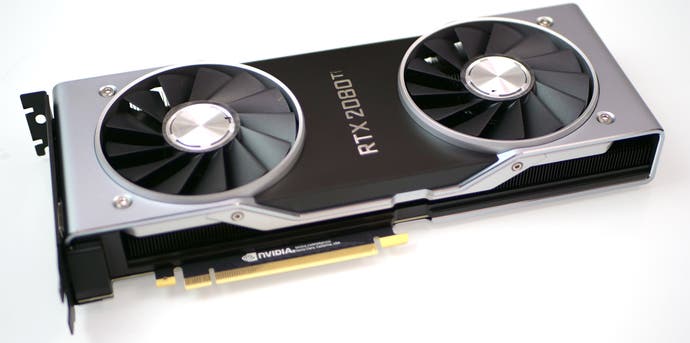GTX 1080 Ti vs RTX 2080 Ti: Which should you buy?
Benchmark performance, value and feature comparison included.
Eighteen months after it debuted as the undisputed champion of Nvidia's consumer graphics card lineup, the GTX 1080 Ti relinquished its throne to the RTX 2080 Ti. As well as boasting better raw performance, the new flagship adds features like hardware acceleration for real-time ray tracing and deep learning super sampling - technology that could change the way we play games. Of course, all of this comes at a price, and for the RTX 2080 Ti, that price often reaches four figures. Is the RTX 2080 Ti worth the upgrade, or does the GTX 1080 Ti remain a credible option - especially if you can find it used at a good price? In this article, we'll give you all the information you need to make that decision for yourself.
The new RTX branding for the new Turing cards suggest a seismic shift in what GPUs can do, so we'll first look at these new features to see whether they're worth the early adopter tax. Real-time ray tracing (RTX) offers more realistic visuals and deep learning super sampling (DLSS) could provide a performance advantage, but how many games support this new technology and what kind of numbers are we talking about? There are other new additions too, so it's worth discussing all of this in a little more detail so you can know what you're getting yourself into.
Of course, outside of games that support these new features, raw performance is the most important metric. We'll show you exactly what kind of frame-rates you can expect in some of the most demanding recent games, including a smorgasbord of 4K results and an in-depth analysis of 1080p and 1440p high-fps performance too.
Pricing and availability are the final pieces of the puzzle, as an all-singing, all-dancing new graphics card isn't worth considering unless you can actually get your hands on one for a reasonable price. Before we head into the head-to-head, it's also worth noting that we've covered some of these issues in greater detail in our full GeForce RTX 2080 and 2080 Ti review, so feel free to open that up in a new tab to read later.

RTX 2080 Ti vs GTX 1080 Ti: feature comparison
Deep learning super-sampling (DLSS)
Let's start with DLSS, because it could be the single most important feature to debut on the new RTX cards. That's because in games that support it, DLSS can provide an incredible performance boost that launches the RTX 2080 and 2080 Ti clear of the competing GTX 1080 Ti by a considerable margin. That extra performance can be key to offsetting the graphical demands of real-time ray tracing, or merely running new games at the high frame-rates demanded by modern 144Hz or 240Hz monitors.
So how does this new technique actually deliver these performance gains? We've covered the topic in an in-depth DLSS feature, but essentially DLSS is a shortcut: a game is rendered at a lower resolution than your screen's native resolution, then upscaled using an efficient deep learning algorithm that has been fed extremely high resolution imagery of the game. This allows the algorithm to fill in the gaps and produce a final image that looks similar to a standard full-size image, while only using around 50 per cent of the shading power, thus allowing for significantly higher frame-rates.
This all sounds well and good, but how much of a performance advantage does DLSS provide? Right now, it's difficult to answer that question broadly, as DLSS has only appeared in a handful of shipping titles. Therefore, we've chosen a Final Fantasy XV demo provided by Nvidia, which could be a best-case scenario or a representative one; at this point, we still don't know. In the Final Fantasy demo at least, the performance gains are monumental - the RTX 2080 Ti gains nearly 40 per cent when switching from traditional temporal anti-aliasing to DLSS, while the combined difference between the GTX 1080 Ti and RTX 2080 Ti is a whopping 80 per cent. It will be extremely interesting to see whether these differentials are mirrored in the twenty-five games that Nvidia has announced will support DLSS in the future; expect a full Digital Foundry examination once these start to arrive later this year!
Final Fantasy 15 demo: TAA vs DLSS
Real-time ray tracing
You may have noticed that Nvidia's new Turing cards have dropped the GTX moniker, instead opting for the RTX brand. This refers to the card's unique real-time ray tracing abilities, where light is accurately modelled as it bounces around a scene to boost graphical fidelity. Real-time ray tracing requires an immense amount of effort even with the RTX cards' dedicated hardware, so expect to toggle this effect on and off to see whether the more realistic lighting and reflections are worth the heavy performance hit. In Battlefield 5, the only game with Nvidia's ray tracing implementation thus far, we've seen even the RTX 2080 Ti lose over half of its performance with RTX on at 1080p. In titles that support both technologies, DLSS and real-time ray tracing could be used together to ensure playable frame-rates, but we haven't seen this combination used yet in a shipping game. That means, like DLSS, RTX on the 2080 Ti largely remains an unknown quantity. Games in five or ten years will almost certainly use this technology or something similar to it, but what about this year or next? We will have to wait and see.
Turing architecture: new rendering features
While RTX and DLSS are the two standout features of the new Turing graphics cards, they're far from the only new additions. Nvidia have also included new shading models, such as mesh shading, which allow graphics cards to have greater control over level of detail settings. That could result in performance gains without any regressions in image quality. Variable rate shading is another clever addition which focuses processing power on scene elements that players are likely to be looking at. A Wolfenstein 2 demo suggests that we could see a healthy 15 to 20 per percent frame-rate boost when the feature is enabled, although as usual, developers will need to specifically implement these new shaders in their games for the advantages to be realised.
The physical connectors on the RTX 2080 Ti are also upgraded over the previous generation, with DisplayPort 1.4a allowing the connection of an 8K display at its full 60Hz refresh rate using only a single cable. Perhaps more practical in the short term, USB-C VirtualLink combines data and video over a single reversible cable for next-generation VR headsets.
Finally, streamers and game video creators will be able to take advantage of an upgraded NVENC encoder. This more efficient hardware and software combination supports a wider range of video standards and should allow for higher resolutions too. More importantly, the encoder uses less CPU resources than its predecessor, especially at high resolutions, which could allow mainstream gaming PCs to stream at full 4K resolution.
RTX 2080 Ti vs GTX 1080 Ti: performance benchmarks
In order to give you a better idea of the gulf in performance between the RTX 2080 Ti and GTX 1080 Ti, we've tested these cards in nine titles from the past few years. To round out our comparison, we've included the RTX 2080 and the GTX 1080 as well. Eight of the games have been tested at 4K resolution, as higher resolutions will best emphasise the difference in performance between these graphics cards. We will however also share our initial 1080p and 1440p results at the end of this section, in order to give more information for gamers using high refresh rate (eg 100Hz, 144Hz or 240Hz) displays.
To give you a better idea of their raw performance, you can also see some of the most relevant stats in the table below. Note that Founders Edition figures are given first, with their reference equivalents in parentheses, as the RTX FE cards we tested come factory overclocked.
| RTX 2080 Ti | RTX 2080 | GTX 1080 Ti | GTX 1080 | |
|---|---|---|---|---|
| CUDA cores | 4352 | 2944 | 3584 | 2560 |
| Giga Rays/sec | 10 | 8 | 1.21 | 1? |
| RTX-OPS | 78T (76T) | 60T (57T) | 12T | 8T |
| VRAM | 11GB GDDR6 | 8GB GDDR6 | 11GB GDDR5X | 8GB GDDR5X |
| Memory Bus | 352-bit | 256-bit | 352-bit | 256-bit |
| Mem. Bandwidth | 616GB/s | 448GB/s | 484GB/s | 352GB/s |
| Base Clock | 1350MHz | 1515MHz | 1480MHz | 1607MHz |
| Boost Clock | 1635MHz (1545MHz) |
1800MHz (1710MHz) |
1582MHz | 1733MHz |
| TDP | 260W (250W) | 225W (215W) | 250W | 180W |
Before we get into the actual results, it's worth mentioning that our benchmarks are displayed in our bespoke Digital Foundry video benchmarking system - at least for desktop visitors to the site. A YouTube video embedded below will show you exactly the scene that we tested each card on, with live frame-rate and frame time data embedded below. Use the controls to the right of the video to swap in different cards or resolutions, and find summarised results in the bar charts below. For these, remember that you need to mouse over the chart to see the average, best and worst one per cent and five per cent figures; you can also click to change between absolute values and percentages. That's enough jibber jabber, so let's get into the results!
Assassin's Creed Odyssey
First up is Assassin's Creed Odyssey, the latest game to be added to our benchmark suite. The game's well-crafted textures and richly detailed materials, combined with the large open world, make for a challenging test even for the Nvidia's top-end consumer card. The RTX 2080 Ti is able to manage 75fps at 1440p, but only 52fps at 4K - so if you want a 4K/60 experience, you'll need to turn down some settings (or, if you really can afford to flash the cash, pick up a second RTX 2080 Ti). The RTX 2080 Ti is 24 per cent faster at 4K than the GTX 1080 Ti.
AC Odyssey: Ultra High, TAA
Assassin's Creed Unity
We continue with Assassin's Creed Unity, the 2014 release that saw protagonist Arno stalk the streets of Revolution-era Paris. The RTX 2080 Ti is the only card that is able to break a 60fps average at 4K, dipping below the prescribed frame-rate only when detailed characters are large on the screen at the ultra high preset that we've chosen. The GTX 1080 Ti is about 28 per cent behind, recording an average of 43fps. That means you'd need to make visual tweaks to achieve a 60fps average on the 1080 Ti, but not on the newer card - progress!
AC Unity: Ultra High, FXAA
Battlefield 1
Next up is 2016 title Battlefield 1, specifically its War Stories mode as there's no built-in benchmark for us to use here. The RTX 2080 Ti eclipses 100fps this time around, coming within tweaking distance of maxing out a 4K 144Hz gaming monitor. The 103fps of the RTX 2080 Ti is a solid 30fps ahead of the GTX 1080 Ti, a difference of about 30 per cent. Note that the frame time spikes in the benchmark results are the result of randomised explosions, and aren't an indicator of performance instability as you would normally expect.
Battlefield 1: Ultra, TAA
Crysis 3
Crysis 3, released all the way back in 2013, is the oldest test we've included in our current benchmark suite. The RTX 2080 Ti is the first card that we've tested to pass the 60fps threshold at 4K here, actually scoring a comfortable 68fps on average. The GTX 1080 Ti sits 20 per cent behind, at a less playable 54fps. As common with older titles, the RTX 2080 is less competitive, offering just 53fps, although few games released five years ago will challenge a modern graphics card to quite the extent that Crysis does!
Crysis 3: very high, SMAA T2X
Far Cry 5
Far Cry 5 is one of the newest titles in our tests, having been released in 2018. The RTX 2080 Ti again is the only card to score in excess of 60fps at 4K, with a final average result of 75fps. In comparison, the GTX 1080 Ti sits relatively far behind at 56fps, a span of nearly 25 per cent. The RTX 2080 is the middle child in this situation, with the smaller RTX card managing just 4fps better than the fastest GTX card.
Far Cry 5: Ultra, TAA
Ghost Recon Wildlands
At last, we've found it: a game where the RTX 2080 Ti can't push 60 frames per second at 4K! Ghost Recon Wildlands, released last year, is the game in question and it remains the most challenging benchmark we have with a challenging built-in benchmark. The RTX 2080 Ti manages just 47fps on average, while the GTX 1080 Ti and RTX 2080 manage 38fps. Overall, the gap between the Ti cards is around 25 per cent. Of course, a G-Sync monitor would allow for playable results at 4K, no matter which card of the three that you're using - especially if you're willing to drop from the ridiculous ultra preset to a more sensible high or very high.
Ghost Recon Wildlands: Ultra, TAA
Rise of the Tomb Raider
We've chosen to evaluate performance in both of the recent Tomb Raider titles, with the first being 2016 release Rise of The Tomb Raider. This game's integrated benchmark remains a good test of GPU performance, although actual gameplay can be significantly more demanding. The RTX 2080 Ti is about 20 per cent ahead of the GTX 1080 Ti here, with an average score of 80fps for the RTX card compared to 63fps for the GTX 1080 Ti. The GTX 1080 Ti outperforms its closest RTX competitor here, although as we'll see that trend doesn't hold forever.
Rise of the Tomb Raider: Very High, SMAA
Shadow of the Tomb Raider
Next is the 2018 Tomb Raider game, Shadow of the Tomb Raider. This game is more graphically challenging than its predecessor, and its benchmark is also more representative of in-game performance. The RTX 2080 Ti is the only card to exceed an average of 60fps once more, and this time there's less than a single frame per second in it! The GTX 1080 Ti doesn't perform as well in this newer game, with an average frame-rate of 43fps and a 28 per cent gap to the RTX 2080 Ti. It's also worth keeping in mind using deep learning super sampling could boost these scores higher, as we saw earlier from the Final Fantasy XV DLSS demo.
Shadow of the Tomb Raider DX12: Highest, TAA
The Witcher 3
2015's The Witcher 3 remains a favourite for gamers and system builders alike, as we evaluate performance by a good old-fashioned Roach ride through the muddy streets of Novigrad. The RTX 2080 Ti manages a solid result of 77fps on average, compared to 60fps for the RTX 2080 - a differential of around 22 per cent. The GTX 1080 Ti is also competitive at 64fps average, so it's another solid result for the older card here.
The Witcher 3: Ultra, POST-AA, No Hairworks
Wolfenstein 2: The New Colossus
Our final benchmark addition is Wolfenstein 2: The New Colossus, which came out late last year. In our benchmark run of a campaign section that sees BJ riding a Panzerhund in New Orleans, the uber preset only limits the RTX 2080 Ti to an impressive 104fps average score. That's a solid 36 per cent improvement over the GTX 1080 Ti, indicating again that newer games seem better suited to RTX hardware.
Wolfenstein 2 Vulkan: Uber, TSSAA 8x
1080p/1440p performance at high refresh rates
We noted earlier that the majority of our testing had been performed at 4K, as this best illustrates the differences between GPUs, in comparison to lower resolutions which are intrinsically more CPU-bound. However, it's still worth investigating how the top cards from Nvidia's Pascal and Turing series compare at lower resolutions in games like Rise of the Tomb Raider, shown below. Here, we can see that at 1080p, there's only a 12 per cent gap between the two flagship cards, rising to nearly 20 per cent at 1440p.
Rise of the Tomb Raider: Very High, SMAA
This shows that if you're targeting lower resolutions at high frame-rates, a GTX 1080 Ti card could prove to be the better performer pound-for-pound. However, more recent DirectX 12 titles like Shadow of the Tomb Raider result in better results for the RTX cards, meaning that while you may save money initially, you also may need to upgrade earlier to play modern games - and that's before taking RTX-exclusive technologies like DLSS and variable rate shading or driver improvements into account.
RTX 2080 Ti vs GTX 1080 Ti: price and availability
The RTX 2080 Ti is far and away the best-performing graphics card on the market, delivering at least 60 frames per second at 4K in all but one of the games that we tested. By comparison, the GTX 1080 Ti only manages that feat in three of the games in our benchmark suite, and largely in older titles.
Another nail in the coffin for the GTX 1080 Ti is that finding the card at a reasonable price is becoming near-impossible as stock has dried up and even used models are sold at a premium. The cheapest GTX 1080 Ti spotted for sale in our retailer survey was £759 in the UK and $1200 in the US; compare this to the RTX 2080 at £600/$700 and you're paying much more for a card that's often slower. By comparison, the cheapest 2080 Ti examples we found retailed for £950 in the UK and $1000 in the US, so choosing the GTX 1080 Ti doesn't really make any sense even if you don't hold any stock in DLSS or RTX.
Of course, while the GTX 1080 Ti is a mature card that's unlikely to get much better, the RTX 2080 and 2080 Ti could well be improved over time. Driver updates and greater developer adoption of technologies like RTX, DLSS and variable rate shading could make the RTX series the only sensible option for gamers building high-end rigs. Even if they end up as niche technologies, the calculus still favours picking up one of Nvidia's Turing cards - or at least waiting for a second RTX generation whenever it comes, perhaps in a few years.
For the moment, the RTX 2080 is the strongest choice of these three high end cards, offering GTX 1080 Ti performance levels at a lower price plus extra technology. Meanwhile, the RTX 2080 Ti makes the most sense for early adopters who want to try the newest technology and 4K gamers who don't want to sacrifice visual fidelity in order to hit a solid 60fps. For other groups, especially gamers using 1080p or 1440p monitors, going with a GTX 1080 Ti and a faster processor is a sensible choice only if you can find one significantly cheaper than a new RTX 2080 card.
For more information on the RTX 2080 Ti, feel free to read or watch our full GeForce RTX 2080 and 2080 Ti review.
Which GPUs are worth buying? We've made our picks for the best graphics cards available, updated with the latest graphics cards as they're released. As well as an overall performance champ, we name the best value graphics card and best cheap graphics card to guide your next upgrade.









